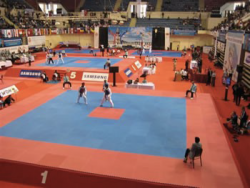Student Booklet - 2nd KUP exam (Red belt)
Student booklet /
Main Menu
Student Booklet - 2nd KUP exam (Red belt)
Exam 2nd Kup
Student booklet
Select the level of the exam or the full booklet in the following box to have the theory you require :
Toi-Gye Historical background (TAEKWONDO YOKSA) for 2nd KUP exam
TOI-GYE - 퇴계 / 退溪 is the pen name of the noted scholar Yi Hwang (16th century), an authority on neo-Confucianism.
The 37 movements of the pattern refer to his birthplace on 37-degree latitude, the diagram represents "scholar" as in the Yul-Gok Tul.
End: Bring the right foot to MOA SOGI B
Back to top of page - Back to Welcome Page
Meaning of the red belt ( TI ) - 2nd Kup
Red belt signifies danger, cautioning the student to exercise self-control and warn the opponents to stay away.
Back to top of page - Back to Welcome Page
Knowledge of Taekwondo for 2nd KUP
Refereeing at competitions
Once you’re a yellow belt, you learn something about the rules. Now we will proceed in how arbitration works on competitions..
Referees are both women and men. This is how it is going.
Sparring
How and what?
A fight usually lasts 2 minutes and is decided by points. If there is a tie after the 2 minutes, another 1 minute of fighting is foreseen. If after that minute there still is no winner, then there will be a golden point.
Golden point sparring is when the two fighters have 1 minute to be the first to make a point. All techniques will give 1 point, even leg techniques to the head. The first one scoring a point according to the referees wins the fight.
Who?
Participants are divided into: chong (blue) and hong (red).
Corner referees: scoring the points. You score a point when one or more (corner referee) saw it.
Center Referee: leading the fight. He starts and stops the fight. He is the person who (center referee) interrupts the fight for giving warnings.
The jury table: The table has a Jury President and is responsible for the ring. He keeps track of which participants have to come after the current contestants. Also, there is a jury member who maintains the warnings for the final decision. The Timekeeper watches the time during the fight. There is one center referee present at the table as a reserve.
Terug naar top van deze pagina - Terug naar de welkom pagina
Points
Items are listed on the points form by the corner referees. After the fight the central umpire receives the corner referees’ forms. Afterwards he brings the forms to the table. Since everything is already counted, the result is communicated by the jury president who names the winner
In sparring, the points are allocated as here below :
- 1 point for all fist techniques on the body or face
- 2 points for all leg techniques on the body
- 3 points for all leg techniques on the face
Warnings:
- Ui Ju Hanna: before a warning is given, the fight is stopped (= heachyo) and then a warning is attributed to the accused person. After three warnings, one point is deducted.
- Gam Jum Hanna: you can get a minus point through full contact (too hard, usually uncontrolled), falling down or ignoring umpire commands. Three direct minus points means disqualification (Sil Kyuk).
You get a warning by :
- Pushing
- Kicking below the belt
- Grabbing opponent
- Performing a technique on the back
- Deliberately avoiding battle (running away)
- Falling down (touch by hand on ground)
- Going out of the ring
- Attacking without looking
- turning away
- talking
- Claiming provoking point
Back to top of page - Back to Welcome Page
Tuls
How and what?
The higher the grade, the more a person has to perform tuls on competition. Colored belts usually performed only one tul.
Who?
There are five judges who assess the Tuls. There is still the table with the referee.
Points
The jury always takes several factors into account, including :
- strength
- balance
- breathing
- technique
- rhythm.
There are two systems used in Tul, namely points or waste system.
The five referees have the duty to designate a winner or a tie. The majority of these five is the winner.
- Example 2 votes for hong and 3 for chong, chong = win.
In the point system, each referee scores points separately.
Separate points are given according to different factors. Maximum 5 points for technique and maximum 3 for strength, balance, breathing or rhythm each. One gets a final score with a maximum value of 17.
Back to top of page - Back to Welcome Page
Team sparring
In team sparring, there are five people per team. There is a toss, the winner decides which team chooses the person to bring forward as first. Points are given as described here below :
- 1 point for a tie
- 2 points for a win
The team with the most points wins.
Team Tul
The same rules as in tul are applied here. It can be assessed using waste system or the points system
A team consists of 3 to 5 people. When the points are returned separately, points are given according to the different factors as in Tul.
There is one additional factor, a maximum of 5 points for presentation, teamwork and choreography. So, a maximum value of 22 points.
Back to top of page - Back to Welcome Page
Special technics
In this discipline, the contestants have to give a kicking technique as high or as far as possible. This is depending on each discipline. A few examples :
- Tymio nopi ap cha busigi
- Tymio nomo yop cha jirugi
- Tymio dollyo chagi
- ...
It is usually a knockout round. IT goes further or higher until there is a winner. On the big competitions, points are used and there, the contestants have to perform various steps before giving the kicking technique.
Power breaking
Here we try to break, with a hand or foot technique, as many boards as possible that are disposed. Also, there can be a waste or points system used. Some techniques :
- Ap jumok jirugi
- Yop cha jirugi
- Bandae dollyo chagi
- ...
Traditional sparring
Here, a style battle is performed by a pair. It only has a few limits and is fully rehearsed by the pair. The referees determine the two winners on several factors. The different duos come taking turns on the ring.
Back to top of page - Back to Welcome Page
THE ULTIMATE TIPS FOR A GOOD TUL
Tul must begin and end on the same spot.
Always have a correct posture, stance and position.
The muscles of the body are completely relaxed after each operation and totally strained during movement.
Rhythmic movement execution and no stiff walking.
All in one coordinated action.
Fast or slow implementation depending on the imposed exercise.
Each tul must be perfectly known before one learns the next.
Know the significance of every move.
Perform each movement with a sense of realism.
Both offensive and defensive techniques, left- and right-hand techniques must as powerful and streamlined as the other.
Each tul is equivalent.
Back to top of page - Back to Welcome Page
Hand-Technique for 2nd KUP
| Korean | English |
|---|---|
| DWIJIBUM SONKUT NAJUNDE BANDAE TULGI | Upset fingertip thrust |
| DUNG JOOMUK YOPDWI TAERIGI | Back fist side back block |
| KYOCHA JOOMUK NOOLLO MAKGI | X-fist pressing block |
| SANG PALKUP YOP TUYLGI | Twin side elbow thrust |
| BAKKAT PALMOK SANG MAKGI | Outer forearm w-shape block |
| DOO PALMOK NAJUNDE MIRO MAKGI | Double forearm low pushing block |
| SANG AP JAPKEE | Grab the head |
Back to top of page - Back to Welcome Page
Foot-Technique for 2nd KUP
| Korean | English |
|---|---|
| MOORUP OLLYO CHAGI | Knee upward kick |
Back to top of page - Back to Welcome Page
Grading to the 2nd Kup (Red Belt)
- All the previous knowledge that you had to learn.
- Meaning of "Toi-Gye"
- New techniques to know, being able to show and explain
- Types of sine wave motions, being able to enumerate and explain
- Explain how umpiring works in Taekwon-Do
- Correctly perform "Chon-Ji" tul
- Correctly perform "Dan-Gun" tul
- Correctly perform "Do-San" tul
- Correctly perform "Won-Hyo" tul
- Correctly perform "Yul-Gok" tul
- Correctly perform "Toi-Gye" tul
- Correctly perform 12 different Sambo Matsugi's (three step sparring)
- Correctly perform 10 different Ibo Matsugi's (two step sparring)
- Correctly perform 12 different Ilbo Matsugi's (one step sparring)
- 2 min fight with a partner for the purpose to demonstrate different learned techniques during a fight
- 15 practical hosinsul techniques to perform with partner
- Break test : 2 breaking techniques performing on wooden shelf of reusable shelf
- TWIMYO YOP CHAGI
- BANDAE DOLLYO CHAGI
Back to top of page - Back to Welcome Page

